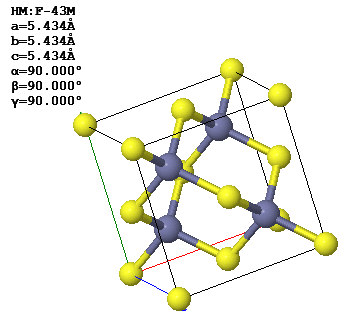
First name
Last name
Matrikelnr.
Problem 1
Nitrogen has an atomic number of 7 and atomic mass of 14 $u$. Oxygen has an atomic number of 8 and atomic mass of 16 $u$. The atomic mass unit is $u=$ 1.6605402 × 10-27 kg. A N2 has a bond length of 1.1 Å and a dissociation energy of 1.76 eV. A O2 has a bond length of 1.2 Å and a dissociation energy of 1.5 eV.
(a) How are the bond lengths and dissociation energies calculated?
(b) The molecular orbitals of O2 are similar to the molecular orbitals of N2. Explain why this is so.
(c) How many molecular orbitals are filled in the ground state of N2?
(d) What determines the rotational energies of molecules like N2 and O2? Which one has a larger spacing between its rotational levels?
(e) How many vibrational modes does O2 have?
Problem 2
GaAs has a fcc Bravais lattice with two atoms in the basis. The lattice constant is $a=$ 5.65 Å.

Some data for the phonon frequencies of the acoustic and optical phonons are
ωTO(Γ) 50.4 × 1012 ωLO (X) 45.4 × 1012 ωLO(Γ) 53.7 × 1012 ωTA(L) 11.7 × 1012 ωTA(X) 14.8 × 1012 ωLA(L) 39.3 × 1012 ωLA(X) 42.7 × 1012 ωTO(L) 49.3 × 1012 ωTO(X) 47.5 × 1012 ωLO(L) 44.9 × 1012
(a) Sketch the phonon dispersion relation for GaAs along X - Γ - L.
(b) How could the phonon dispersion relation be measured experimentally?
(c) How could you determine the speed of sound from the dispersion relation?
(d) Sketch the phonon density of states that corresponds to the dispersion curve that you have drawn.
(e) What quantities can you calculate from the phonon density of states?
Problem 3
The plane wave method can be used to calculate the band structure of a material. The starting point is the single particle Schrödinger equation.
(a) What is the Schrödinger equation for an electron moving in a potential $V(\vec{r})$?
The potential and the wave function are expressed as Fourier series,
\begin{equation} V(\vec{r})=\sum\limits_{\vec{G}}V_{\vec{G}}e^{i\vec{G}\cdot\vec{r}},\hspace{1.5cm}\psi(\vec{r})=\sum\limits_{\vec{k}}C_{\vec{k}}e^{i\vec{k}\cdot\vec{r}}. \end{equation}These expressions are substituted into the Schrödinger equation and terms with the same wavelength are collected together. This results in the central equations,
\begin{equation} \left(\frac{\hbar^2k^2}{2m}-E\right)C_{\vec{k}}+\sum\limits_{\vec{G}}V_{\vec{G}}C_{\vec{k}-\vec{G}}=0. \end{equation}These equations are solved for every $\vec{k}$ vector in the first Brillouin zone.
Consider 1-D periodic potential, $V(x)=\cos(\pi x)$ where $x$ is measured in Ånstroms. There are only two terms in the Fourier series for the potential $\cos(\pi x)=(e^{i\pi x}+e^{-i\pi x})/2$.
(b) Write down the central equations as a 3 × 3 matrix. Which values of $G$ are you including?
(c) Describe how the electronic dispersion relation ($E$ vs. $k$) is calculated in the plane wave method. How many bands will be plotted using this matrix?
Problem 4
The properties of some semiconductors are listed in the table below.
$N_c$ | $N_v$ | $E_g$ | |
Si (300 K) | 2.78 × 1025 m-3 | 9.84 × 1024 m-3 | 1.12 eV |
Ge (300 K) | 1.04 × 1025 m-3 | 6.0 × 1024 m-3 | 0.66 eV |
GaAs (300 K) | 4.45 × 1023 m-3 | 7.72 × 1024 m-3 | 1.424 eV |
4H-SiC (300 K) | 1.7 × 1025 m-3 | 2.5 × 1025 m-3 | 3.3 eV |
(a) What is the chemical potential for intrinsic Ge measured from the top of the valence band at 300 K?
(b) Draw the density of states for Ge as a function of energy near the top of the valence band and the bottom of the conduction band. Explain how you used the data from the table above to make this drawing.
(c) Germanium is an indirect semiconductor. The valence band maximum is at k = 0 but the conduction band minimum is in the <111> direction. How many conduction band minima are there?
(d) Describe the relationship between the effective density of states and the effective mass. (You don't need to give the formula, just describe in words how they are related.)
Quantity | Symbol | Value | Units | |
| electron charge | e | 1.60217733 × 10-19 | C | |
| speed of light | c | 2.99792458 × 108 | m/s | |
| Planck's constant | h | 6.6260755 × 10-34 | J s | |
| reduced Planck's constant | $\hbar$ | 1.05457266 × 10-34 | J s | |
| Boltzmann's constant | kB | 1.380658 × 10-23 | J/K | |
| electron mass | me | 9.1093897 × 10-31 | kg | |
| Stefan-Boltzmann constant | σ | 5.67051 × 10-8 | W m-2 K-4 | |
| Bohr radius | a0 | 0.529177249 × 10-10 | m | |
| atomic mass constant | mu | 1.6605402 × 10-27 | kg | |
| permeability of vacuum | μ0 | 4π × 10-7 | N A-2 | |
| permittivity of vacuum | ε0 | 8.854187817 × 10-12 | F m-1 | |
| Avogado's constant | NA | 6.0221367 × 1023 | mol-1 |